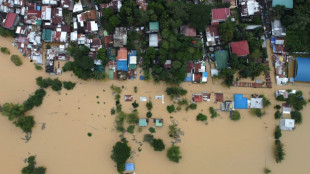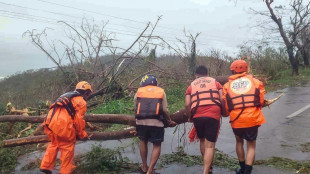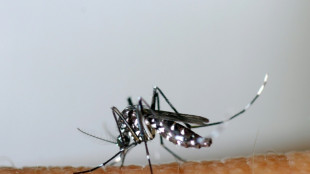
-
 Kane hoping to extend England career beyond 2026 World Cup
Kane hoping to extend England career beyond 2026 World Cup
-
Gazans rebuild homes from rubble in preparation for winter

-
 'Vague' net zero rules threaten climate targets, scientists warn
'Vague' net zero rules threaten climate targets, scientists warn
-
'Agriculture is dying': French farmers protest EU-Mercosur deal

-
 Beyonce to headline halftime during NFL Christmas game
Beyonce to headline halftime during NFL Christmas game
-
Rescuers struggle to reach dozens missing after north Gaza strike

-
 Russia vetoes Sudan ceasefire resolution at UN
Russia vetoes Sudan ceasefire resolution at UN
-
G20 host Brazil launches alliance to end 'scourge' of hunger

-
 Trump confirms plan to use military for mass deportation
Trump confirms plan to use military for mass deportation
-
Schools closed in Beirut after deadly Israeli air raid

-
 Anger, pain in Turkey as 'newborn deaths gang' trial opens
Anger, pain in Turkey as 'newborn deaths gang' trial opens
-
UN climate chief at deadlocked COP29: 'Cut the theatrics'

-
 Stocks, dollar mixed as traders scale back US rate cut bets
Stocks, dollar mixed as traders scale back US rate cut bets
-
Stoinis lets rip as Australia crush Pakistan for T20 series whitewash

-
 Bentancur banned for seven games over alleged racial slur
Bentancur banned for seven games over alleged racial slur
-
Kremlin says Biden 'fuelling' tensions with Kyiv missile decision

-
 COP host Azerbaijan jailed activists over 'critical opinions': rights body
COP host Azerbaijan jailed activists over 'critical opinions': rights body
-
Composer of Piaf's 'Non, je ne regrette rien' dies aged 95

-
 South African trio nominated for World Rugby player of year
South African trio nominated for World Rugby player of year
-
'Not here for retiring': Nadal insists focus on Davis Cup

-
 Tractor-driving French farmers protest EU-Mercosur deal
Tractor-driving French farmers protest EU-Mercosur deal
-
Floods hit northern Philippines after typhoon forces dam release

-
 Pakistan skittled for 117 in final T20 against Australia
Pakistan skittled for 117 in final T20 against Australia
-
Schools closed in Beirut after deadly Israeli strike

-
 Chris Wood hits hat-trick in NZ World Cup qualifying rout
Chris Wood hits hat-trick in NZ World Cup qualifying rout
-
US, Philippines sign deal on sharing military information

-
 Bangladeshi ex-ministers face 'massacre' charges in court
Bangladeshi ex-ministers face 'massacre' charges in court
-
Law and disorder as Thai police station comes under monkey attack

-
 Disgraced Singapore oil tycoon sentenced to nearly 18 years for fraud
Disgraced Singapore oil tycoon sentenced to nearly 18 years for fraud
-
Quincy Jones awarded posthumous Oscar

-
 'Critically endangered' African penguins just want peace and food
'Critically endangered' African penguins just want peace and food
-
Long delayed Ukrainian survival video game sequel set for release amid war

-
 Star Australian broadcaster charged with sex offences
Star Australian broadcaster charged with sex offences
-
Philippines cleans up after sixth major storm in weeks

-
 Woman-owned cafe in Indonesia's Sharia stronghold shakes stigma
Woman-owned cafe in Indonesia's Sharia stronghold shakes stigma
-
Indigenous Australian lawmaker who heckled King Charles censured

-
 End of an era as Nadal aims for winning Davis Cup farewell
End of an era as Nadal aims for winning Davis Cup farewell
-
Trump taps big tech critic Carr to lead US communications agency

-
 Mitchell-less Cavs rip Hornets as perfect NBA start hits 15-0
Mitchell-less Cavs rip Hornets as perfect NBA start hits 15-0
-
Markets swing after Wall St losses as traders weigh US rates outlook

-
 India's capital shuts schools because of smog
India's capital shuts schools because of smog
-
Rio under high security for G20 summit

-
 G20 leaders to grapple with climate, taxes, Trump comeback
G20 leaders to grapple with climate, taxes, Trump comeback
-
Hopes set on G20 spurring deadlocked UN climate talks

-
 Gabon early results show voters back new constitution
Gabon early results show voters back new constitution
-
Child abuse police arrest star Australian broadcaster

-
 Disgraced Singapore oil tycoon to be sentenced for fraud
Disgraced Singapore oil tycoon to be sentenced for fraud
-
Stray dogs in Giza become tourist draw after 'pyramid puppy' sensation

-
 UN Security Council to weigh call for immediate Sudan ceasefire
UN Security Council to weigh call for immediate Sudan ceasefire
-
Is AI's meteoric rise beginning to slow?


Rare baby elephant twins born in Kenya
An elephant in Kenya has given birth to twins, an extremely rare event, conservationists said Thursday.
Conservation group Save the Elephants said the twins -- one male and one female -- were born to a mother named Bora.
They were first spotted by lucky tourist guides on a safari drive at the weekend in Samburu reserve in northern Kenya.
Videos show the days-old newborns getting accustomed to their savannah surroundings with their doting mother and an older sibling, Bora's first calf, born in 2017.
African elephants have the largest gestation period of any living mammal, carrying their young for nearly 22 months, and gives birth roughly every four years.
"Twins are rarely encountered in elephant populations and form about only one percent of births," Save the Elephants' founder Iain Douglas-Hamilton said in a statement.
However, elephant twins do not often fare so well. The last pair of twins born in Samburu, in 2006, failed to survive more than a few days.
"Quite often the mothers don't have enough milk to support two calves," Douglas-Hamilton said.
"The next few days will be touch-and-go for the new twins, but we all have our fingers crossed for their survival."
There are an estimated 36,280 elephants in Kenya, according to the country's first-ever national wildlife census conducted last year.
That figure represented a 12-percent increase in population numbers recorded in 2014, when killing for ivory was higher.
The population of African savanna elephants plunged by at least 60 percent in the last half century, prompting their reclassification as "endangered" in the latest update to the IUCN's "Red List" of threatened species.
M.A.Vaz--PC


